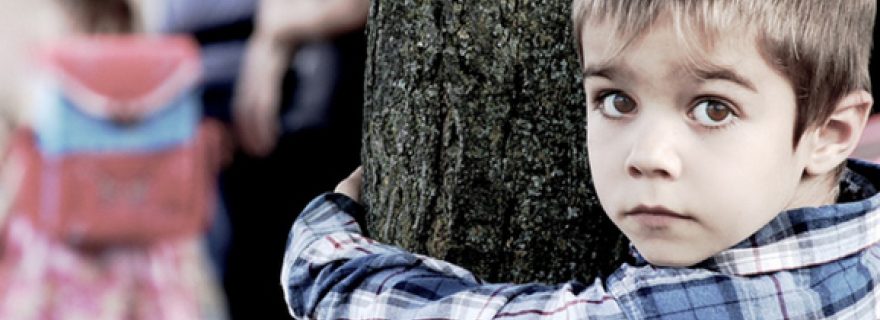Shy? What about your family?
Being shy is a familiar experience for many people. And most people are nervous when they have to speak in a group. But what if serious anxiety gets the better of you in social situations?
Imagine…
Imagine: you have to give an important presentation in front of an audience. You are the center of attention and all eyes are on you. How do you feel? Or: you are invited to a party where you don’t know anyone. You enter the room and see that the other guests are already seated. What do you experience? Chances are you feel shy and uncomfortable in the beginning, tense maybe, but after a while these feelings will fade and you will have a good time. However, some people remain extremely nervous in social situations and even worry for days or weeks before a social event. These people have an intense fear of being negatively evaluated and are severely worried about doing something embarrassing in front of others. As a result, they try to avoid social situations as much as possible. This tendency could have a tremendous negative influence on their lives. They suffer from a psychiatric condition: Social Anxiety Disorder (SAD).
Social Anxiety Disorder
The lifetime prevalence of SAD is around 10%. The effects of the disorder should not be underestimated: patients with SAD often experience problems at work, in activities with friends, and in their close relationships. In addition, patients with SAD have an above-average risk of suffering from alcohol addiction and mood disorders such as depression. This makes SAD a very disabling condition.
Suffering in silence
SAD often develops during late childhood and adolescence, when children are very sensitive to the opinion of others. Unfortunately, many patients take a long time (sometimes over 20 years!) to seek help for their anxiety and suffer in silence in the meantime. However, there are therapies available that could alleviate social anxiety symptoms. Cognitive behavioral therapy, in which patients focus on their anxious thoughts, and drugs such as selective serotonin reuptake inhibitors (SSRIs) are generally effective ways to diminish social anxiety. Nevertheless, prevention is better than cure. But to develop effective preventive interventions, we need insight into the factors that make individuals vulnerable for developing SAD.
It runs in the family
Previous research has revealed that SAD has a genetic basis: children of patients with SAD have a five times higher risk of developing the disorder themselves, while another study reported that first-degree relatives of SAD patients are even ten times more likely to have the condition than people without SAD sufferers in their immediate family. In addition, studies in twins indicate that SAD is partly heritable. So there seems to be a SAD-specific genetic background that makes individuals vulnerable to developing SAD. Until now, the genetic variations related to SAD are largely unknown, and, for several reasons, not easy to find. First of all, the disorder differs from one patient to another: some experience anxiety in specific social situations, while others are extremely tense at every social event. On the other hand, it is assumed that multiple interacting genes play a role in the development of SAD. This complicates the search for a link between social anxiety and genes. However, new approaches and new study designs can help to unravel this connection.
Leiden Family Study on Social Anxiety
In 2013, a team of researchers (and I am very proud to be one of them) from Leiden University and Leiden University Medical Center (LUMC) started a large two-generation family study on SAD. This family study is unique, in that we not only investigate patients with SAD, but also invite their partners and children to come to the lab, as well as the patients’ siblings and their partners and children. Within these families, we aim to determine so-called endophenotypes of SAD: characteristics that are genetically linked to the disorder and that make individuals vulnerable to developing SAD. Since endophenotypes are viewed as characteristics that are in between genes and behavior (in this case: social anxiety), they can facilitate the search for SAD-related genetic variations.
Work in progress
Until now, 9 families with a total of 136 family members have participated in the Leiden Family Study on Social Anxiety. As we speak, the data of these participants are being analyzed. We are investigating how social anxiety runs in the families and will test the hypothesis that the level of social anxiety symptoms depends on the degree of blood relationship. In addition, we are working on the neuroimaging analyses of Electroencephalography (EEG) and Magnetic Resonance Imaging (MRI) data. The focus of these analyses is the question whether characteristics of neuroimaging data could serve as endophenotypes of SAD.
The international potential of the Leiden Family Study on Social Anxiety is reflected in the line-up for the forthcoming Lorentz Workshop, which will be completely devoted to the discussion of candidate endophenotypes of SAD. This workshop takes place in Leiden from 14-18 December, and we welcome experts from all over the world to discuss this fascinating new line of research with us.
In summary, we are looking forward to a very exciting year, in which we hope to learn more about the genetic basis of SAD. This is important. Although socially anxious people would be the last to ask for special attention themselves, we do need to pay attention to their disorder and continue to gain more insight into the development of this serious condition.





